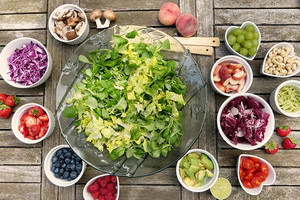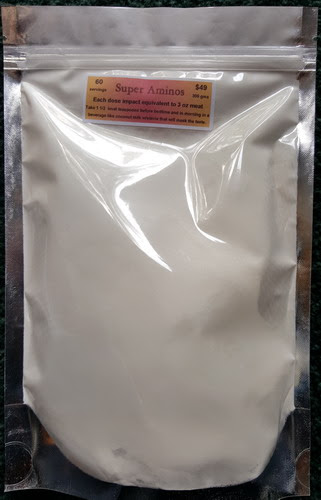We are made of protein. Protein is the structural element of everything living. Protein is made out of tiny pieces called amino acids. They function like Lego blocks and pieces. With enough pieces you can make just about anything. Amino acids only contain 10 to 20 atoms each and in the human body there are 22 different kinds of amino acids that make up the thousands of proteins that make us up. There are a few other amino acids that just float around doing other stuff not protein related. Proteins on the other hand contain anywhere from 20 amino acids all linked up to thousands upon thousands of amino acids all connected in complex ways to form the microscopic tools and machines that run our cells. Each cell in our body contains 1 to 3 billion protein molecules. It is as though if each person was a single protein, a single cell would be the size of North America. This gives you some idea of how hugely complex each tiny cell is, and we are made of trillions of these cells.
So protein is important. It is the stuff of life. As you might expect, making sure we have the right proteins in the right amounts in our diet to build and maintain our body is pretty important. This is a significant issue in many third world countries where overt protein deficiency produces the disease marasmus and kwashiorkor. In this country the primary protein deficiency disease is called cachexia and is

associated with old age and especially cancer. You see this with the muscle wasting in the aged and the poor quality of their skin and ligaments. Osteoporosis can be a protein deficiency issue.
Younger people in this country rarely have issues with overt protein deficiency as we tend to eat so much meat, however this can be a problem for vegans. As we age our digestive ability decreases and we have a harder time breaking the huge protein molecules down into the individual amino acids which are able to cross the gut lining and enter our blood supply. The first step in protein breakdown begins in the stomach with the hydrochloric acid in the stomach unfolding the complex protein structure. If you have problems with your stomach acid or are taking drugs to stop your stomach acid than you can not digest your proteins. The next step is the tearing apart of the long chain of amino acids in the protein by the enzymes from the pancreas. Many of us do not produce

enough enzymes – both from age and also because enzymes are themselves proteins. If our ability to digest proteins is compromised for a time, then we end up short on the ability to form the enzymes we need to give us more protein with which to make more enzymes.
Years ago I created my Miracle Protein bread mix, partly because I wanted a low carb/ gluten free/ grain free bread. But the secondary reason I created the bread mix was to provide a source of protein for seniors. I was seeing many of my senior patients using Ensure and similar food replacement drinks which are little more than sugar filled chocolate milk. The last thing they need is a bunch of sugar. What they need is better protein, and my Miracle Protein bread provides that in a form they will eat. Each loaf has as much protein as a 2 1/2 pound chuck steak.
Since that time I have seen a new problem – all the antacid drugs like Prilosec and Zantac block protein digestion. Now we have a new issue. The patients may be eating plenty of protein, but they are unable to digest enough of it to be healthy. A second issue has been the recent social move to plant-based diets. While you can get sufficient protein from a plant-based diet, most people don’t. Plant-based diets require

you to do protein complementing because each plant protein source is deficient in different essential amino acids. If you do not eat multiple plant sources that complement each other to compensate for the deficiencies each plant has, you end up deficient.
What are essential amino acids? Some amino acids our body can create from the basic elements, but eleven of the amino acids have to be obtained from our diet. Meat will have all these essential amino acids, but individual plants do not.
This is like the article I wrote last month about essential fatty acids that we have to get from our diet. There are also certain amino acids that are considered conditionally essential. What that means is that we can make them in our body in very limited amounts. Under various conditions we might need a lot more than we can build. The amino acid glycine and the peptide taurine are two examples of this. These days we need much more of each of these than we can manufacture in our body.
How much protein do we need each day? That answer depends on our age and activity level. When you are young and growing rapidly, you need a lot more than when you are

middle aged. If you are older and have poor digestion, your needs are similar to a child’s. If you are weight lifting to build muscle, you need extra protein. But for the average person, you need around 70 – 90 grams of protein each day. This number is somewhat misleading however. Almost half of the substance of most proteins is made of the amino acid glutamine, which is mostly used by the cells of the gut and burned for energy. In fact by the time the protein you have eaten is digested down to amino acids, absorbed, and run through the liver, almost 80% is used for purposes other than forming the structural proteins the body needs.
Our actual amino acid need from protein is much smaller, particularly if you allow your body to shift into autophagy regularly by not eating. Autophagy recycles the damaged proteins back into amino acids to be reused to make new proteins. Clinical studies on patients put on fasting protocols found that on average they could maintain full muscle mass and good skin tone by supplementing their fast with only 10 grams of just the essential amino acids in the precise ratio needed by the body. This become especially important for

patients using metabolic approaches to cancer in which they starve the cancer by avoiding the main food cancer eats – carbohydrates. But cancers will switch to using the amino acid glutamine for energy just like the gut lining cells do. Avoiding protein to avoid the glutamine in this therapy causes the patients to waste away. They need the amino acids essential to keep their body healthy while fighting the cancer, but they need to avoid the most common amino acid in protein. Fortunately glutamine is not one of the essential amino acids, and can be avoided by using a precisely balanced ratio of just the amino acids needed for health.
My personal interest in this subject has to do with my cyclic fasting for health. I use a version of the precise amino acid ratio I call Super Aminos in my fasting cycle. I don’t use them while fasting for a few days as they will stop autophagy. I want autophagy as this is the fountain of youth process in the body. But the night I stop my fast I start pumping in the Super Aminos to rebuild the body for a few days. The fasting really pumps up the growth hormone levels, which stay elevated for

a few days while I have cycled back into eating proteins and a few carbs. This really maximizes the tissue rebuilding as I replace old worn out tissues with new better ones. This is my health rejuvenation reboot program.
On the other hand, I use the Super Aminos for my mother as she is 89 years old. She recently had surgery for a collapsed vertebra so she needs extra protein for healing and keeping up her muscle strength. She takes a dose of Super Aminos morning and night. With her the goal is to keep her muscles strong so she can keep up with her busy lifestyle.
The only problem with Super Aminos is that many of the essential amino acids taste really bitter. Initially I put the product into capsules for myself, but I just couldn’t tolerate taking 20 500mg capsules at a time. I have learned to “take my medicine” by hiding it in avocado milk or coconut almond milk along with stevia drops. It is not great, but doable. My

mother says she has no problem with it – but then she also likes that nasty bitter stuff called coffee – I never have. I am just a wimp when it comes to bitter taste. On the plus side, taking it as a powder keeps the cost down to less than half of what other essential amino acid products cost. That makes it taste much better on some level. I put my essential fatty acids in with it at the same time to really give me all my essential macronutrients in one glass.
I have not had my Super Amino acid blend in the office for patients as I figured the taste would make it unacceptable to them. But a couple patients have insisted they want it anyway, so I will bag up a few 1 month bags to have available for those who might be interested for $49.
The original research on this particular blend was done before it was realized that L-Histidine is an essential amino acid, so the blend they researched only had 10 amino acids in it. I have corrected for this issue in my blend. I am also considering putting out a blend of glycine and taurine, because they are conditionally essential and we are meeting those conditions big time these days.
